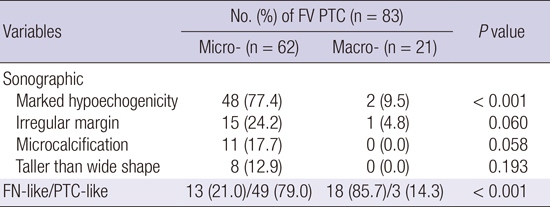1. Cooper DS, Doherty GM, Haugen BR, Kloos RT, Lee SL, Mandel SJ, Mazzaferri EL, McIver B, Pacini F, Schlumberger M, et al. Revised American Thyroid Association management guidelines for patients with thyroid nodules and differentiated thyroid cancer. Thyroid. 2009; 19:1167–1214.
2. Jossart GH, Clark OH. Well-differentiated thyroid cancer. Curr Probl Surg. 1994; 31:933–1012.
3. Kumar PV, Talei AR, Malekhusseini SA, Monabati A, Vasei M. Follicular variant of papillary carcinoma of the thyroid. A cytologic study of 15 cases. Acta Cytol. 1999; 43:139–142.
4. Zidan J, Karen D, Stein M, Rosenblatt E, Basher W, Kuten A. Pure versus follicular variant of papillary thyroid carcinoma: clinical features, prognostic factors, treatment, and survival. Cancer. 2003; 97:1181–1185.
5. Tielens ET, Sherman SI, Hruban RH, Ladenson PW. Follicular variant of papillary thyroid carcinoma. A clinicopathologic study. Cancer. 1994; 73:424–431.
6. Lang BH, Lo CY, Chan WF, Lam AK, Wan KY. Classical and follicular variant of papillary thyroid carcinoma: a comparative study on clinicopathologic features and long-term outcome. World J Surg. 2006; 30:752–758.
7. Rosai J, Carcangiu ML, Delellis RA, editors. Atlas of tumor pathology. Tumors of the thyroid gland. Washington, D.C.: Armed Forces Institute of Pathology;1992. p. 42–121.
8. In : Hedinger C, Williams ED, Sobin LH, editors. Papillary carcinoma. Histological typing of thyroid tumours: World Health Organization international histological classification of tumours. 2nd ed. Berlin: Springer-Verlag;1988. p. 9–10.
9. Chang HY, Lin JD, Chou SC, Chao TC, Hsueh C. Clinical presentations and outcomes of surgical treatment of follicular variant of the papillary thyroid carcinomas. Jpn J Clin Oncol. 2006; 36:688–693.
10. Cardenas MG, Kini S, Wisgerhof M. Two patients with highly aggressive macrofollicular variant of papillary thyroid carcinoma. Thyroid. 2009; 19:413–416.
11. Liu L, Venkataraman G, Salhadar A. Follicular variant of papillary thyroid carcinoma with unusual late metastasis to the mandible and the scapula. Pathol Int. 2007; 57:296–298.
12. Passler C, Prager G, Scheuba C, Niederle BE, Kaserer K, Zettinig G, Niederle B. Follicular variant of papillary thyroid carcinoma: a long-term follow-up. Arch Surg. 2003; 138:1362–1366.
13. Burningham AR, Krishnan J, Davidson BJ, Ringel MD, Burman KD. Papillary and follicular variant of papillary carcinoma of the thyroid: initial presentation and response to therapy. Otolaryngol Head Neck Surg. 2005; 132:840–844.
14. Yu XM, Schneider DF, Leverson G, Chen H, Sippel RS. Follicular variant of papillary thyroid carcinoma is a unique clinical entity: a population-based study of 10,740 cases. Thyroid. 2013; 23:1263–1268.
15. Baloch ZW, Gupta PK, Yu GH, Sack MJ. LiVolsi VA. Follicular variant of papillary carcinoma. Cytologic and histologic correlation. Am J Clin Pathol. 1999; 111:216–222.
16. Moon WJ, Jung SL, Lee JH, Na DG, Baek JH, Lee YH, Kim J, Kim HS, Byun JS, Lee DH. Benign and malignant thyroid nodules: US differentiation--multicenter retrospective study. Radiology. 2008; 247:762–770.
17. Chan BK, Desser TS, McDougall IR, Weigel RJ, Jeffrey RB Jr. Common and uncommon sonographic features of papillary thyroid carcinoma. J Ultrasound Med. 2003; 22:1083–1090.
18. Hoang JK, Lee WK, Lee M, Johnson D, Farrell SU. Features of thyroid malignancy: pearls and pitfalls. Radiographics. 2007; 27:847–860.
19. Komatsu M, Hanamura N, Tsuchiya S, Seki T, Kuroda T. Preoperative diagnosis of the follicular variant of papillary carcinoma of the thyroid: discrepancy between image and cytologic diagnoses. Radiat Med. 1994; 12:293–299.
20. Rago T, Di Coscio G, Basolo F, Scutari M, Elisei R, Berti P, Miccoli P, Romani R, Faviana P, Pinchera A, et al. Combined clinical, thyroid ultrasound and cytological features help to predict thyroid malignancy in follicular and Hupsilonrthle cell thyroid lesions: results from a series of 505 consecutive patients. Clin Endocrinol (Oxf). 2007; 66:13–20.
21. Baloch ZW, Tam D, Langer J, Mandel S. LiVolsi VA, Gupta PK. Ultrasound-guided fine-needle aspiration biopsy of the thyroid: role of on-site assessment and multiple cytologic preparations. Diagn Cytopathol. 2000; 23:425–429.
22. Edge SB, Byrd DR, Compton CC, Fritz AG, Greene FL, Trotti A, editors. AJCC cancer staging manual. 7th ed. New York, NY: Springer;2010.
23. Leenhardt L, Bernier MO, Boin-Pineau MH, Conte Devolx B, Maréchaud R, Niccoli-Sire P, Nocaudie M, Orgiazzi J, Schlumberger M, Wémeau JL, et al. Advances in diagnostic practices affect thyroid cancer incidence in France. Eur J Endocrinol. 2004; 150:133–139.
24. Yoon JH, Kim EK, Hong SW, Kwak JY, Kim MJ. Sonographic features of the follicular variant of papillary thyroid carcinoma. J Ultrasound Med. 2008; 27:1431–1437.
25. Kim DS, Kim JH, Na DG, Park SH, Kim E, Chang KH, Sohn CH, Choi YH. Sonographic features of follicular variant papillary thyroid carcinomas in comparison with conventional papillary thyroid carcinomas. J Ultrasound Med. 2009; 28:1685–1692.
26. Rhee SJ, Hahn SY, Ko ES, Ryu JW, Ko EY, Shin JH. Follicular variant of papillary thyroid carcinoma: distinct biologic behavior based on ultrasonographic features. Thyroid. 2014; 24:683–688.
27. Park JY, Lee JI, Tan AH, Jang HW, Shin HW, Oh YL, Shin JH, Kim JH, Kim JS, Son YL, et al. Clinical differences between classic papillary thyroid carcinoma and variants. J Korean Endocr Soc. 2009; 24:165–173.
28. Kim KW. Clinical characteristics of papillary thyroid cancer in Korea. J Korean Thyroid Assoc. 2010; 3:111–115.
29. Cibas ES, Ali SZ. The Bethesda system for reporting thyroid cytopathology. Thyroid. 2009; 19:1159–1165.
30. Ivanova R, Soares P, Castro P, Sobrinho-Simões M. Diffuse (or multinodular) follicular variant of papillary thyroid carcinoma: a clinicopathologic and immunohistochemical analysis of ten cases of an aggressive form of differentiated thyroid carcinoma. Virchows Arch. 2002; 440:418–424.








 PDF
PDF ePub
ePub Citation
Citation Print
Print







 XML Download
XML Download